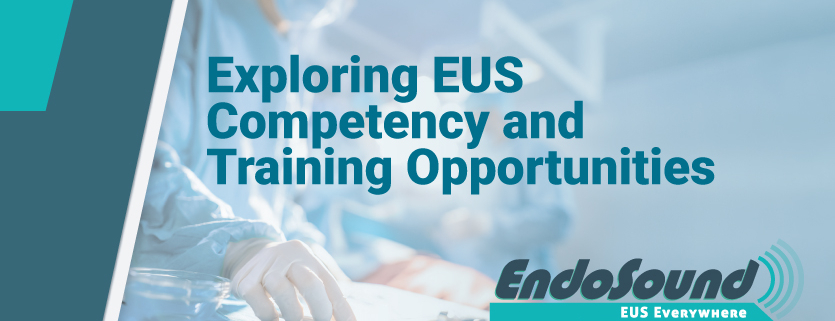Exploring EUS Competency and Training Opportunities
It is estimated between 60 and 70 million people in the U.S. are affected by digestive diseases and gastrointestinal endoscopy has played an increasingly major role in management of those disorders.
While safer than, and often preferable to, invasive surgery, endoscopic procedures ranging from routine colonoscopy to more advanced procedures like endoscopic ultrasound (EUS) and endoscopic retrograde cholangiopancreatography (ERCP) are not without risk. Physician competency is paramount to patient safety and can prevent misdiagnosis or poor treatment.
Competency in GI endoscopy is often measured by number of procedures completed in formal training programs, like post-residency fellowships. However, there is no formal specialized endoscopy board for the discipline, meaning training varies greatly across the nation and globe.
As the popularity of the discipline grows and endoscopic technology and techniques continue to evolve over time, it’s worth looking at what training opportunities are available, particularly for endoscopists who may choose later in their career to pursue more advanced endoscopic therapies in their practice.
Measuring Competency in EUS
EUS is an advanced endoscopic procedure used to assess and treat digestive and lung diseases (EBUS). Endoscopists use a specialized endoscope to take ultrasound images of the lining of walls of digestive system or lungs, or obtain images of organs like the pancreas and liver. These images can prove essential in the diagnosis of digestive or respiratory diseases. Additionally, endoscopists can perform therapies during more complex EUS procedures.
The American Society for Gastrointestinal Endoscopy (ASGE) recommends at least 24 months of GI or formal surgical training for GI endoscopists seeking competency in EUS. Further procedural requirements for competency, as outlined by the society, include:
- Mucosal tumors: 75
- Submucosal lesions only: 40
- Mucosal and submucosal lesions: 100
- Pancreaticobiliary: 75
- EUS-guided FNA
- Non-pancreatic: 25
- Pancreatic: 25
- Comprehensive competence: 50
The society also notes that competency in one type of advanced endoscopic procedure, such as EUS, does not guarantee competency in another like ERCP. Unique procedural requirements are set forth for each, as the skillsets required are quite different.
While EUS is typically performed at high-volume medical centers, especially given the procedural requirements for competency, there has been increased interest in smaller centers for physicians to take on the diagnostic and therapeutic practice.
Dr. Stephen Steinberg, co-founder and president of EndoSound, describes EUS as an “incremental skill.” There are less complex EUS procedures that can be performed competently with fewer training hours than the more advanced practices, he said. Still, beginning with these less complex procedures can be a pathway to improving skills and offer a way for endoscopists to gather the imagery that will still be helpful in diagnoses and recommendations for care.
EUS Training Post-Medical School
There are currently 86 fellowship programs for advanced endoscopy, according to the American College of Gastroenterology (ACG). But, after fellowship, options become more limited.
“In the U.S., it’s really hard to get hands on experience,” Steinberg said, especially if the endoscopist is not part of a formal training program or fellowship. “Getting temporary privileges to work in another state for training isn’t typically available in the U.S.”
This leads many physicians to pursue advanced endoscopy training abroad.
In a 2014 op-ed penned by Dr. Todd Baron of the University of North Carolina, Dr. Baron explores the roadblocks he faced in pursuing EUS competency mid-career. Given how nationwide post-residency fellowship programs are geared to newly trained physicians, Dr. Baron said he did much of his training outside of the U.S. He said many physicians may find the same path challenging given the year needed to complete a fellowship and a medical center’s reluctance to losing a practicing physician for that length of time.
The COVID-19 pandemic has put even more pressure on developing new opportunities for EUS training that fall outside the realm of a traditional post-residency fellowship. During pandemic-era lockdowns, most non-emergency endoscopy procedures were delayed or postponed, greatly impacting the ability to train new endoscopists in the field. Thus, hands-on models and simulators, virtual conferences, and endoscopic video rounds were used more commonly.
Additionally, Steinberg said the availability of online videos or virtual training sessions and web streaming of live events can help those seeking new EUS skills learn techniques or see the latest available technologies.
Looking Forward
A recent article for the ACG Case Reports Journal outlined some avenues in which advanced endoscopy training could change to provide greater access to more physicians, including:
- Incorporating EUS and ERCP training into the final year of residency
- Standardizing advanced endoscopy training across fellowship programs
- More exploration of non-traditional methods of training
GI endoscopy offers a safe and viable way for patients to receive preventative and therapeutic care without invasive surgery. More advanced procedures like EUS allow physicians to get a detailed look at the advancement of digestive and respiratory illnesses with minimal risk and discomfort to often quite ill patients.
Like most fields of medicine, endoscopy is ever evolving, making further opportunities for training increasingly important. There’s a real appetite for more training in EUS, especially as the procedure becomes more critical to endoscopic treatment, Steinberg said. This is especially noticeable as the ASGE training program for EUS is oversubscribed, he added.
New techniques and technologies are being developed all the time; to keep pace post fellowship training must accompany these advancements to continue to progress endoscopy. Endoscopists and patients alike would benefit from more exposure to new techniques and advanced technologies.


